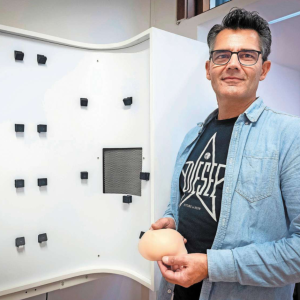Nieuws
terug naar overzichtThe fascinating world of 3D printing
On the MAAK terrain many entrepreneurs are working with 3D printing and the field lab 3D Makerszone is located there. Read more background in this article.
The history
3D printing, also known as additive manufacturing, is a technology that has seen tremendous growth in recent decades. The foundation of this technology was laid in the 1980s by American engineer Chuck Hull, who filed the first patent for stereolithography (SLA) in 1984. SLA uses a UV laser to harden layers of photopolymer to create three-dimensional objects. This was the beginning of a revolution that continues to influence us to this day.
In the 1990s, companies such as Stratasys and 3D Systems began to commercialize the technology. Stratasys introduced fused deposition modeling (FDM), a technique that melts thermoplastics and deposits them layer by layer to build an object. This was a major step forward, as it made the technology more accessible and affordable to various industries.
The pioneers
In addition to Chuck Hull and the founders of Stratasys, many other pioneers have contributed to the development of 3D printing. In the Netherlands, Materialise, founded by Fried Vancraen in 1990, plays a crucial role. Materialise started as a small company in Leuven, Belgium, but has since built a strong presence in the Netherlands. The company is known for its innovative software and applications in the medical sector, such as custom-made implants and surgical devices.
Applications
3D printing has a wide range of applications. In the medical world, 3D printers are used to print prostheses, implants and even tissue structures. Dutch hospitals such as the Erasmus MC in Rotterdam use 3D-printed models to prepare complex operations.
In the aerospace industry, Airbus uses 3D printing to produce lightweight yet strong parts, reducing the weight of aircraft and saving fuel.
Innovative applications are also seen in architecture. Dutch company MX3D has printed a fully functional steel bridge that spans a canal in Amsterdam. This project demonstrates how 3D printing can transform the construction industry by creating complex structures that are difficult to achieve using traditional methods.
The Latest Developments
The technology behind 3D printing continues to develop rapidly. One of the latest trends is the rise of 4D printing, which uses materials that can change shape after printing in response to external stimuli such as heat or moisture. This opens the door to dynamic and adaptive structures.
Another exciting area is bioprinting, where living cells are used to print biological structures such as organs. In the Netherlands, Utrecht University is a pioneer in this field, with research into printing tissue for transplants and regenerative medicine.
Different methods
There are several methods of 3D printing, each with its own advantages and applications:
- Stereolithography (SLA): Uses UV light to harden liquid resin. Suitable for detailed and smooth objects
- Fused Deposition Modeling (FDM): Melts filaments of thermoplastics and builds layer by layer. Widely used due to low cost and availability of materials
- Selective Laser Sintering (SLS): Uses lasers to sinter powder to form a solid structure. Ideal for strong and complex parts
- Digital Light Processing (DLP): Similar to SLA, but uses a digital projector screen to illuminate and solidify layers
- Electron Beam Melting (EBM): Uses electron beams to melt metal powder. Often used in the aerospace and medical industries
Materials for 3D Printing
The choice of materials for 3D printing is vast. Plastics such as PLA and ABS are popular for consumer printers because of their ease of use and affordability. For industrial applications, metals such as titanium and aluminum are used because of their strength and durability.
Composites and biocompatible materials are also gaining ground. In the medical sector, for example, biopolymers are used that can be broken down by the body, making them ideal for temporary implants and tissue regeneration.
Leading Companies and Institutions
The Netherlands plays a prominent role in the world of 3D printing. Companies such as Ultimaker, known for their user-friendly desktop 3D printers, and Shapeways, a platform for 3D printing services, set the tone.
In addition, there are important institutions such as the 3D Maker Zone in Haarlem. This innovation space offers companies and individuals the opportunity to experiment with 3D printing and other advanced technologies. Another notable initiative in Haarlem is MAAK, a circular innovation hub where makers and entrepreneurs are busy developing new products and ideas using 3D printing. See below this blog for a list of MAAKers who are involved in 3D printing.
Expectations for the Future
The future of 3D printing looks promising. The technology continues to evolve, with improvements in speed, precision and material diversity. In the construction industry, we can expect to see more buildings and infrastructure being built using 3D printing, potentially leading to faster and more sustainable construction.
In the medical world, the dream of printing functional organs for transplantation is still in development, but progress is promising. In the consumer market, 3D printers will also become increasingly user-friendly and affordable, potentially making them a household staple.
In short, 3D printing has the potential to fundamentally change the way we live and work. The Netherlands, with its innovative companies and institutions, remains an important player in this exciting technological revolution.
MAKERs involved in 3D printing:
- Neolithic – Betonprinten
- RFX Propmaking & Studio Mensink – Propmaking en prototyping
- Multi 3D Print – Verkoop en service 3d Printers
- 3D Orbit – 3D printing services
- More Than Layers – Advanced 3D printing Design and products
- Freemelt – Metal 3D printing
- 3D makerszone – Fieldlab, events, innovatie trajecten
- EVE Borstprotheses – 3D geprinte mallen voor borstprotheses
- D3Aak – Circulaire 3d geprinte sloep
- Marc Maakt Het – Productontwerp en prototyping
- Veldtwerk – Productontwikkeling
- DotX Control Solutions – besturingssoftware en algoritmes












